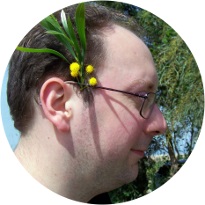
Computational Concepts
in Biology II

This article is about a lecture that is held at the University of Vienna in the summer term. It is a part of the Master's programme in Computational Science, which can be accessed by graduates of a Bachelor's programme in Computer Science, Mathematics or Natural Sciences.
Written by Claus Volko
Vienna, Austria, Europe
Contact: cdvolko (at) gmail (dot) com
Homepage: www.cdvolko.net
As I already wrote in Genycs #1, at the University of Vienna, an interesting new Master's programme was introduced only a couple of years ago (in 2013). This Master's programme is called "Computational Science" and it is highly interdisciplinary. To be admitted for this Master's programme, you need to have a Bachelor's degree in Computer Science, Mathematics, Biology, Physics, Chemistry, Astronomy, Geology or a related field. The Master's programme has a minimum duration of two years and afterwards, you can enroll for a PhD programme.
"Computational Science" is all about research in natural sciences that is done using computers and most of all self-written computer programs. It it thus an ideal study programme for people who are both into computers as well as natural sciences. Depending on what type of Bachelor's degree students have, they either have to attend basic lectures in mathematics, basic lectures in computer science or advanced lectures in these fields. In addition, they have to attend lectures about all of the aforementioned branches of science - physics, chemistry, biology, geology and astronomy, especially lectures about computational approaches to scientific problems. Moreover, students have to complete a Master's thesis.
The lecture "Computational Concepts in Biology I" is a new lecture that had not been held at the University of Vienna before this new Master's programme was freshly introduced. It is an obligatory lecture for all students of the Master's programme. It is held in the winter term, two academic hours a week. I wrote about this lecture back in Genycs #1.
In the summer term 2018, I attended most of the lectures belonging to "Computational Concepts in Biology II". Since the lecture was held in the late afternoon, I was able to attend it although I am already working in the software industry and not a student any more. In this article I am going to tell you about what I learned in the lecture.
The lecturers involved in "Computational Concepts in Biology II" were, among others, Thomas Rattei, Jörg Menche, Filipa L. Sousa and Andras Aszodi. Unfortunately there were three lecturers whose names I do not remember.
Computational Biology is quite a broad field and it basically consists of two components: Bioinformatics and Computational Systems Biology. The lecture "Computational Concepts in Biology I" was more about the former subfield, while the latter subfield was supposed to be dealt with in the lecture "Computational Concepts in Biology II".
In the first lecture of "Computational Concepts in Biology II", Thomas Rattei talked about exact string matching algorithms, including Boyer-Moore, suffix trees and suffix arrays. This is something computer science students at the Vienna University of Technology ususally learn about in their mandatory algorithm classes, so it was mostly a repetition for me.
The next lecture dealt with microbial ecology. In this field of science, computers are mainly used to predict the species based on DNA sequences and which species it might be phylogenetically related to. The lecturer presented a couple of algorithms for prediction of the probability of a sequencing error and for splitting sequences with minimizing the entropy. The latter type of algorithm has the purpose to split a long sequence in possible partial sequences and thus increase the probability that a homology will be found.
I was unable to attend the third lecture due to work, but I recall that in the fourth lecture, topics included diversity (richness, evenness), the Shannon index, the Hill Diversity index, principal component analysis and clustering.
In the next lecture, Jörg Menche, an employee of CeMM (the Center of Molecular Medicine hosted by the Austrian Academy of Sciences), talked about network medicine. He mainly presented basics of graph theory (which I knew from my computer science studies) and mentioned a recent paper written by a researcher named Gerstein.
The week after, Filipa L. Sousa talked about homology, orthology, paralogy and xenology, i. e. how genes and species can be related to each other (by common ancestry, by duplication of a gene, etc.).
Then it was again Thomas Rattei's time. He hosted an exercise session to practice suffix arrays. Afterwards he talked about genome sequence assembly and graph theory (Hamiltonian circles, Eulerian circles, De Bruijn graphs).
In the two following lectures, Andras Aszodi talked about the theory of evolution, artificial life, cellular automata, Tierra and Avida. The final lecture was about system theory, but I had to skip it due to physical illness.
All in all, a nice lecture. There is also a book I can recommend if you are interested in working in the field, it is called "Bioinformatics and Functional Genomics" and was written by Jonathan Pevsner. It was published by Wiley Blackwell.
I also maintain a website about Computational Systems Biology and Artificial Life, the so-called "Web Portal on Computational Biology", which can be accessed by the following URL: http://www.computational-biology.life/
Claus Volko